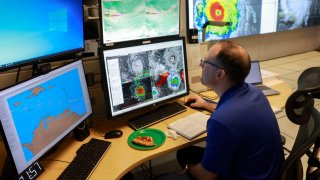
- Jamaica on Wednesday announced an island-wide curfew as record-breaking Hurricane Beryl moved toward its shores after causing widespread destruction in the Caribbean.
- The tropical cyclone has set a string of records that experts say are tied to climate change, as it developed faster and much earlier in the year.
Hurricane Beryl has been declared the strongest-ever hurricane in July, breaking the latest in a series of records as it causes widespread destruction in the Caribbean.
The tropical cyclone has set numerous records that experts say are tied to climate change, as it developed faster and much earlier in the year than similar phenomena. It is the strongest hurricane on record for both June and July and saw the most rapid intensification of any hurricane before Sept. 1 — typically the more intense period of the Atlantic season, which runs from June 1 to Nov. 30.
On Monday, Beryl was declared a Category 5 hurricane — the highest rating on the Saffir-Simpson Hurricane Scale, declared when winds reach 157 miles per hour, according to a webpage from the National Oceanic and Atmospheric Administration, or NOAA.
Get top local stories in Philly delivered to you every morning. >Sign up for NBC Philadelphia's News Headlines newsletter.
Scientists have for years warned that global warming will cause hurricanes to intensify more rapidly due to warmer waters, giving people less time to brace for their impact.
The NOAA previously forecast an 85% chance of an "above-normal" 2024 hurricane season in the Atlantic. It forecast that between 17 and 25 named storms will be observed during the period, versus an average of 14, along with eight to 13 hurricanes, above a typical average of seven. Four to seven of these are projected as likely to develop into major hurricanes, compared with an average of three.
That is in part due to the El Niño-Southern Oscillation, a long-observed climate pattern that generally strengthens hurricane activity in either the Pacific or the Atlantic due to water temperatures. Meteorologists forecast a La Niña phase, marked by factors including cooler ocean surface temperatures in the Pacific, to develop between July and September.
Money Report
Beyond that, ocean temperatures in the Atlantic Basin are currently at record-warm levels and were closer in May to the usual level of late August, according to the NOAA.
Jamaica on Wednesday announced an island-wide curfew as Beryl moved toward its shores.
At least six people have been killed to date, as the hurricane continues to wage destruction. Three people reportedly died in Grenada and Carriacou, with another person killed in St. Vincent and the Grenadines, and two casualties in northern Venezuela, the Associated Press reported.
"I am now declaring the whole of Jamaica to be a disaster area, in accordance with section 26 of the Disaster Risk Management Act, for the next seven days," Jamaican Prime Minister Andrew Holness said in a video address in the early hours, declaring an island-wide curfew between 6 a.m. and 6 p.m. local time on Wednesday. He added that the hurricane, which is expected to bring life-threatening winds, a storm surge and possible floods, highlights the impact of climate change.
"While our carbon emissions are minuscule, our region bears the brunt of the impacts of the change," Holness said.
The tropical cyclone has already passed over the islands of Grenada and St. Vincent and the Grenadines. One resident on the small Union Island told the BBC that "almost the whole island is homeless." Other locals said food, water, first aid kits and power are in short supply.
— CNBC's Ruxandra Iordache contributed to this article.






